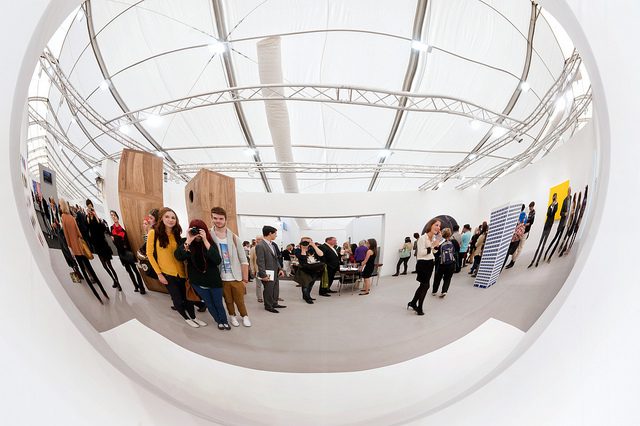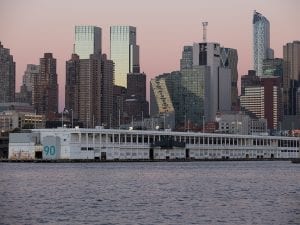Text by Emily Sack
The past weekend one of the most renowned international art fairs settled into London’s Regents Park for an autumnal weekend of exploring galleries and artists well known and newly emergent. With 173 galleries representing 33 countries, Frieze Art Fair brings together some of the best artists from around the world.
Immediately entering the pavilion, the amount of people and immense space to cover is overwhelming, but the excitement of so much art in one place soon overpowers the initial shock. Frieze is divided into two primary categories: the main portion occupied by more well-known galleries such as Lisson Gallery, White Cube and Wallspace, among many others, and Frame, a section devoted to young galleries presenting a single artist’s work.
In a prime location for visibility, the Lisson Gallery utilizes their large space to promote the diversity of artists represented by the gallery. From large painted and altered canvases by 2010 Turner Prize short-listed artist Angela de la Cruz to monumental reflective sculpture by Anish Kapoor, a variety of media are represented. Other artists displayed by Lisson include Richard Wentworth, Julian Opie, Marina Abramović, and Rashid Rana. The overall display is a bit chaotic but the individual works still manage to demand attention and shine individually.
Located in a somewhat distant corner, the Johnen Galerie of Stockholm presents an interesting collection of works. Most notably is David Hahlbrock’s A Possible Forest (2011) that creates a tree from individually sculpted wooden pieces. The tree is formed by a web of mismatched and carefully organized branches. This piece reflects a minor theme found throughout Frieze of sustainability and man’s ability to replicate or create nature. Standing against a brightly papered wall, A Possible Forest is subtle and poetic.
While some exhibition spaces relied on simplicity, others became high-profile showpieces. The Frith Street Gallery contained large-scale works by Tacita Dean lining the walls, but the main centerpiece was Cornelia Parker’s 30 Pieces of Silver (with reflection) of 2003. In this work, fifteen silver dinner service pieces are suspended from the ceiling partnered with a reflection or shadow, created by melting and flattening a matching object. The two pieces hang several inches above the floor at a perpendicular angle from each other creating the illusion of a mirror or reflecting pool hovering in the gallery space. The spectacle was heightened by almost entirely enclosing the space and limiting the number of visitors allowed inside.
Though London boasts an impressive number of international artists, it is refreshing to see galleries from Asia, South America and continental Europe promoting the best of their artists. The Tomio Koyama Gallery based both in Tokyo and Kyoto showcased Yuko Someya who creates mixed media works referencing traditional Japanese watercolours but in a completely contemporary manner. These works emphasize the delicacy of traditional works but incorporate a collage aesthetic and give the natural subjects an edgier feel.
Other notable works include large-scale plans by Christo for the Arizona River project and others at Annely Juda Fine Art, London and Aristarkh Chernyshev and Alexei Shulgin’s Invisible Messages (2011) at XL Gallery, Moscow that incorporated hidden messages within a sculpture only visible through a digital camera or camera phone. Many inquisitive viewers were also found puzzling Martha Friedman’s Cucumber (2003, 2011) displayed by Wallspace, New York. This work contained polyurethane cucumbers suspended between sheets of plexiglass. Throughout Frieze there were inspirational pieces and displays and also those that were just purely entertaining.
Among the Frame galleries, Hunt Kastner of Prague stood out for its display. Representing Eva Kotatkova, the exhibition contained several neo-Dadaist works utilizing the muted colour palatte and college techniques that characterize the European strands of this early twentieth-century movement. While many of the galleries and artists represented in most of the fair are well-known, it is exciting and refreshing to discover newer artists.
A visit to Frieze Art Fair is incomplete without a walk around the Sculpture Park. Ten artists represented by ten galleries installed representative pieces in the beautiful surroundings of Regents Park. From the humourous Angry Pins (2011) by Des Hughes containing three enlarged pins featuring angry facial expressions to the whimsical Circle Dance(2010) by Tom Friedman depicting a ring of dancing silver-coloured children, the works in the sculpture park are as varied as those within the pavilion. Overall the experience of Frieze, though initially overwhelming, is full of discovery and activity granting an expansive exposure to the international art world.
Aesthetica Magazine
We hope you enjoy reading the Aesthetica Blog, if you want to explore more of the best in contemporary arts and culture you should read us in print too. You can buy it today by calling +44(0)1904 479 168. Even better, subscribe to Aesthetica and save 20%. Go on, enjoy!
Image:
Frieze Art Fair 2011
Photo by Linda Nylind Courtesy of Linda Nylind/ Frieze





